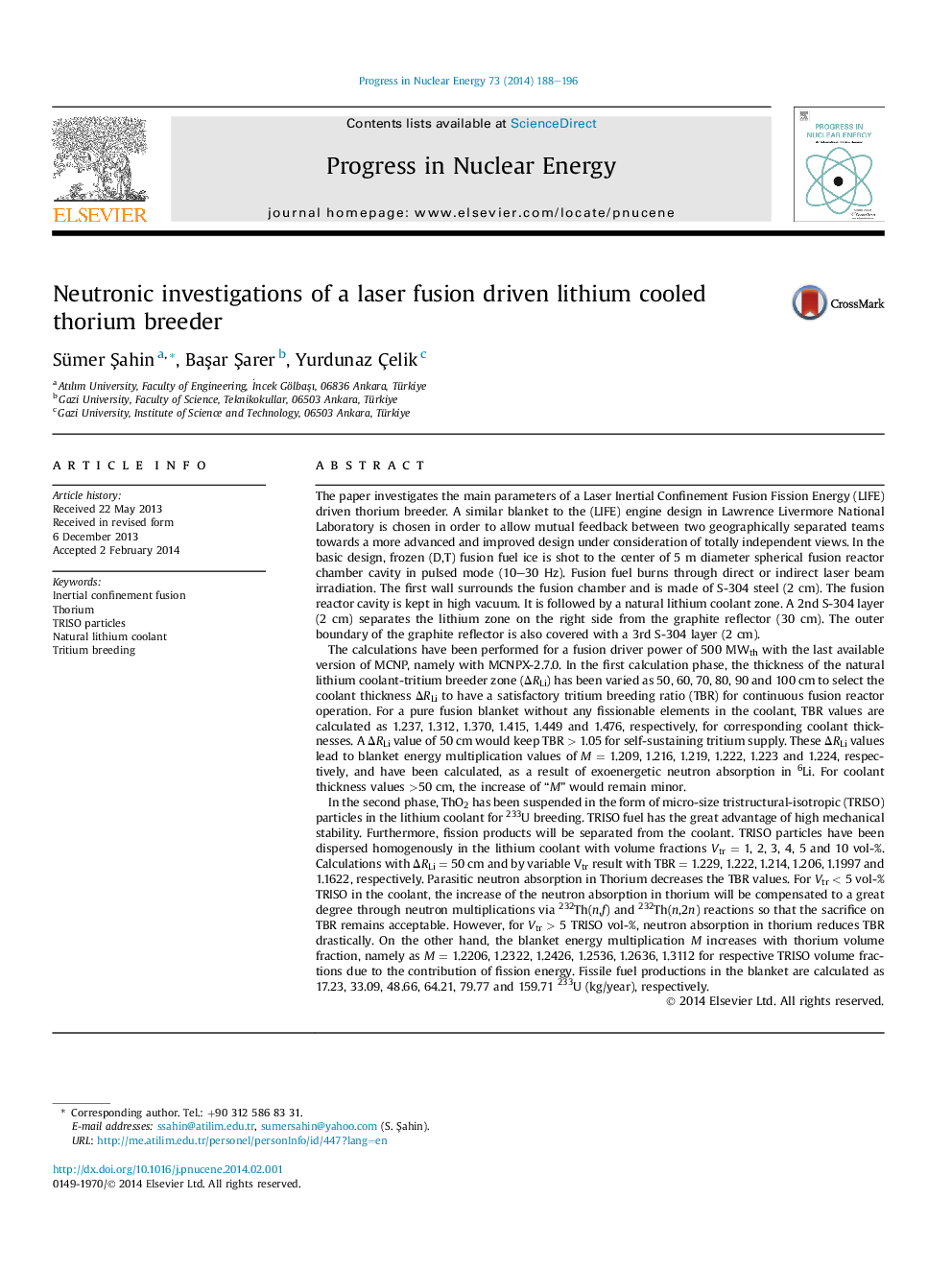| Article ID | Journal | Published Year | Pages | File Type |
|---|---|---|---|---|
| 1740720 | Progress in Nuclear Energy | 2014 | 9 Pages |
•Laser Inertial Confinement Fusion Fission Energy engine as thorium breeder.•Natural lithium coolant for tritium breeding is used.•ThO2 has been suspended in form of TRISO particles for 233U breeding as micro-size particles in the lithium coolant.•233U fissile fuel production rate is evaluated.
The paper investigates the main parameters of a Laser Inertial Confinement Fusion Fission Energy (LIFE) driven thorium breeder. A similar blanket to the (LIFE) engine design in Lawrence Livermore National Laboratory is chosen in order to allow mutual feedback between two geographically separated teams towards a more advanced and improved design under consideration of totally independent views. In the basic design, frozen (D,T) fusion fuel ice is shot to the center of 5 m diameter spherical fusion reactor chamber cavity in pulsed mode (10–30 Hz). Fusion fuel burns through direct or indirect laser beam irradiation. The first wall surrounds the fusion chamber and is made of S-304 steel (2 cm). The fusion reactor cavity is kept in high vacuum. It is followed by a natural lithium coolant zone. A 2nd S-304 layer (2 cm) separates the lithium zone on the right side from the graphite reflector (30 cm). The outer boundary of the graphite reflector is also covered with a 3rd S-304 layer (2 cm).The calculations have been performed for a fusion driver power of 500 MWth with the last available version of MCNP, namely with MCNPX-2.7.0. In the first calculation phase, the thickness of the natural lithium coolant-tritium breeder zone (ΔRLi) has been varied as 50, 60, 70, 80, 90 and 100 cm to select the coolant thickness ΔRLi to have a satisfactory tritium breeding ratio (TBR) for continuous fusion reactor operation. For a pure fusion blanket without any fissionable elements in the coolant, TBR values are calculated as 1.237, 1.312, 1.370, 1.415, 1.449 and 1.476, respectively, for corresponding coolant thicknesses. A ΔRLi value of 50 cm would keep TBR > 1.05 for self-sustaining tritium supply. These ΔRLi values lead to blanket energy multiplication values of M = 1.209, 1.216, 1.219, 1.222, 1.223 and 1.224, respectively, and have been calculated, as a result of exoenergetic neutron absorption in 6Li. For coolant thickness values >50 cm, the increase of “M” would remain minor.In the second phase, ThO2 has been suspended in the form of micro-size tristructural-isotropic (TRISO) particles in the lithium coolant for 233U breeding. TRISO fuel has the great advantage of high mechanical stability. Furthermore, fission products will be separated from the coolant. TRISO particles have been dispersed homogenously in the lithium coolant with volume fractions Vtr = 1, 2, 3, 4, 5 and 10 vol-%. Calculations with ΔRLi = 50 cm and by variable Vtr result with TBR = 1.229, 1.222, 1.214, 1.206, 1.1997 and 1.1622, respectively. Parasitic neutron absorption in Thorium decreases the TBR values. For Vtr < 5 vol-% TRISO in the coolant, the increase of the neutron absorption in thorium will be compensated to a great degree through neutron multiplications via 232Th(n,f) and 232Th(n,2n) reactions so that the sacrifice on TBR remains acceptable. However, for Vtr > 5 TRISO vol-%, neutron absorption in thorium reduces TBR drastically. On the other hand, the blanket energy multiplication M increases with thorium volume fraction, namely as M = 1.2206, 1.2322, 1.2426, 1.2536, 1.2636, 1.3112 for respective TRISO volume fractions due to the contribution of fission energy. Fissile fuel productions in the blanket are calculated as 17.23, 33.09, 48.66, 64.21, 79.77 and 159.71 233U (kg/year), respectively.
